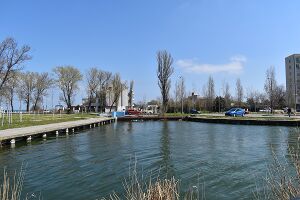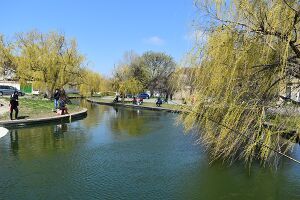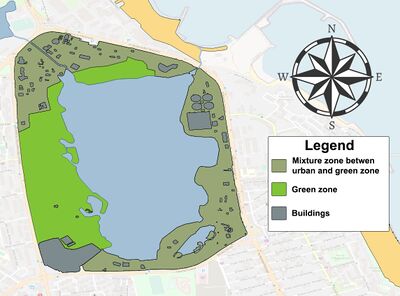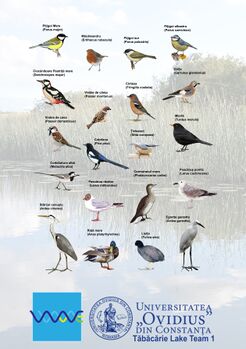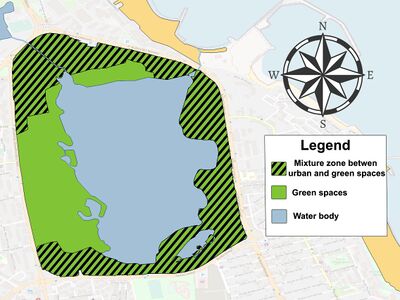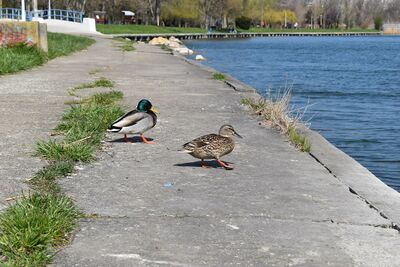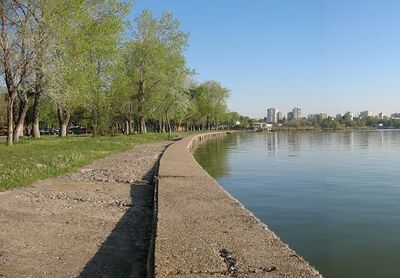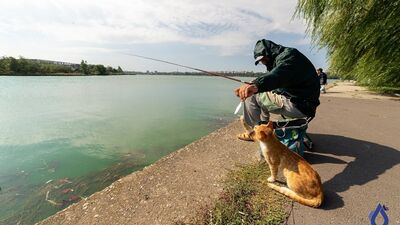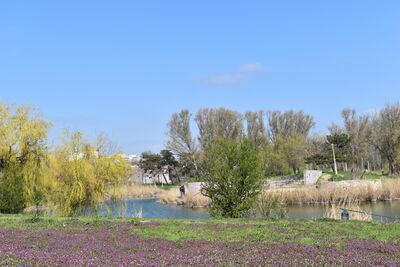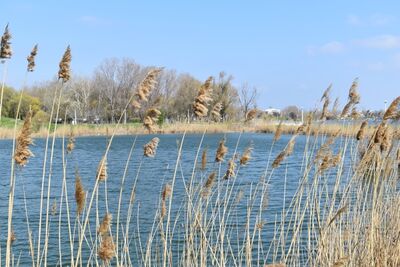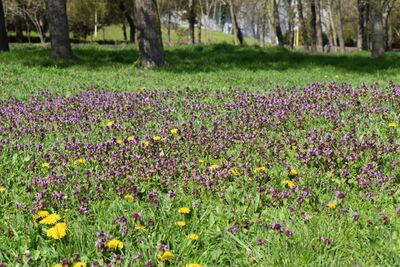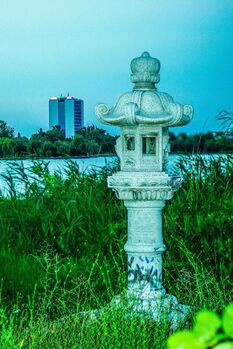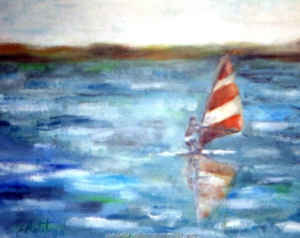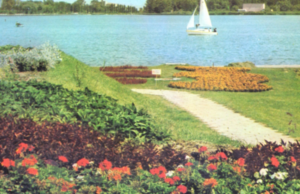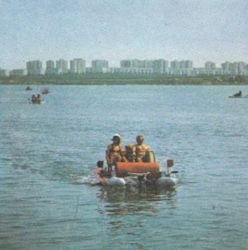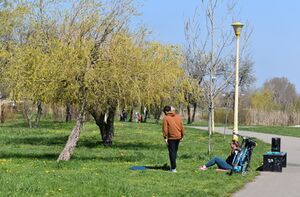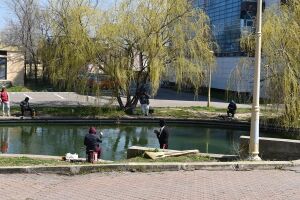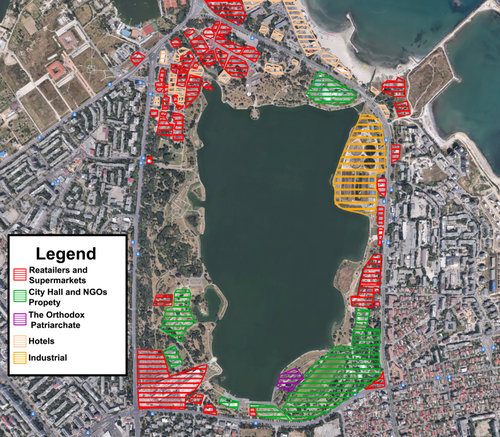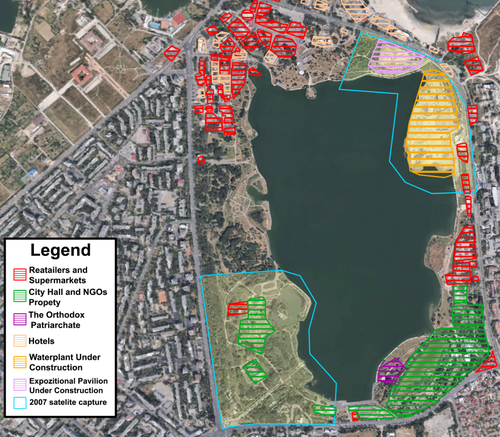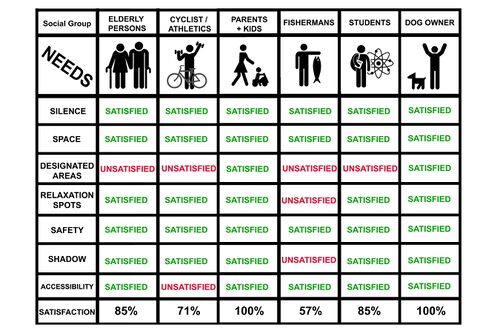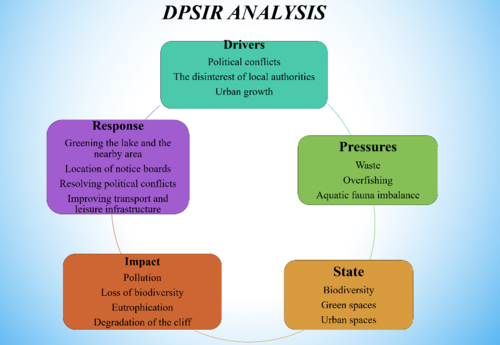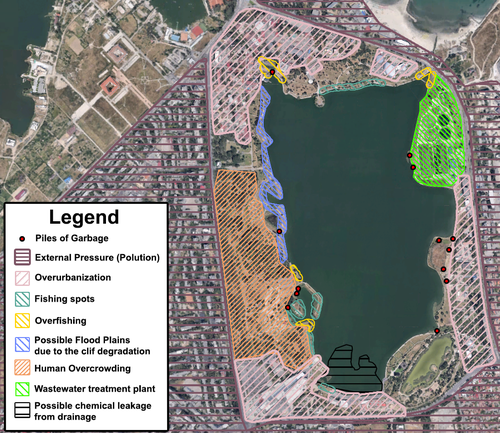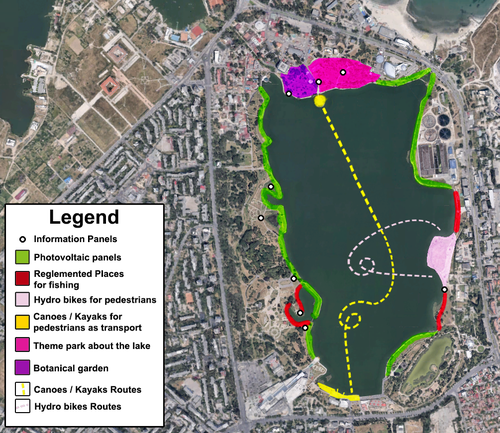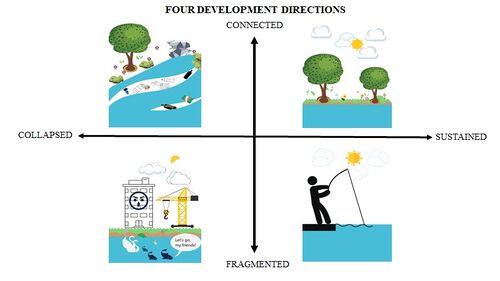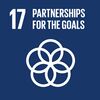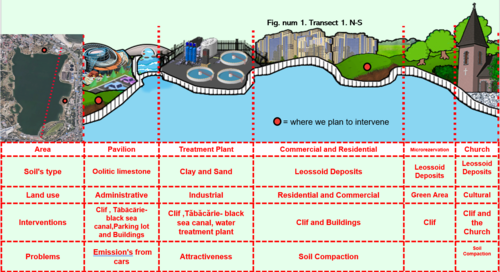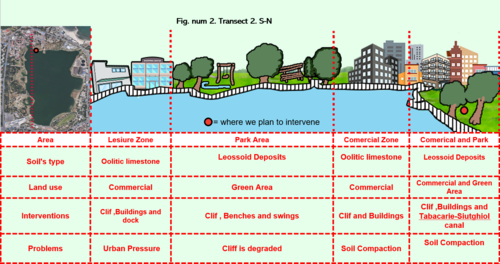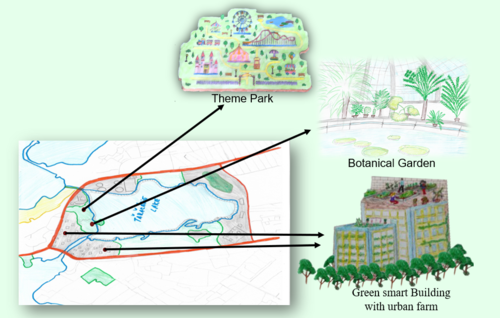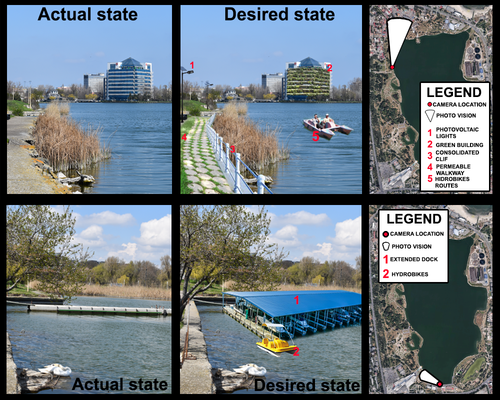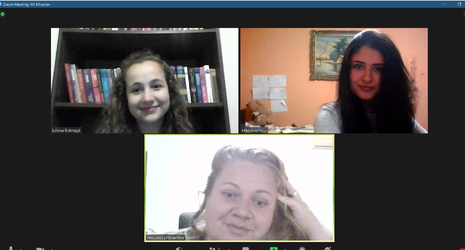Lacul Tăbăcăriei Team 1 Living Lab 2021: Difference between revisions
| Line 554: | Line 554: | ||
*''add map(s) and visualizations'' | *''add map(s) and visualizations'' | ||
<gallery caption=" " widths="500px" heights="400px" perrow=" | <gallery caption=" " widths="500px" heights="400px" perrow="2"> | ||
File:Transect1cta.png|''Transect N-S'' | File:Transect1cta.png|''Transect N-S'' | ||
File:Transect2cta.png|''Transcet S-N'' | File:Transect2cta.png|''Transcet S-N'' | ||
</gallery> | </gallery> | ||
<gallery caption=" " widths="500px" heights="400px" perrow=" | <gallery caption=" " widths="500px" heights="400px" perrow="2"> | ||
File:3.png|''Concrete interventions drawing illustrated '' | File:3.png|''Concrete interventions drawing illustrated '' | ||
File:PLAN.png|''Concrete interventions edited illustrated '' | File:PLAN.png|''Concrete interventions edited illustrated '' | ||
Revision as of 14:54, 27 May 2021
>>>back to working groups overview
| Area | Tăbăcărie Lake | |
| Place | Constanța | |
| Country | Romania | |
| Topics | WAVE Project | |
| Author(s) | Harcotă Andrei-Bogdan, Bulmagă Iuliana-Vasilica , Nica Mădălina,Gavrilescu Carla, Visterneanu Florentina | |

| ||
Rationale
- Why do you think this case is relevant? What is your hypothesis considering the landscape challenges?
The urbanization process is constantly growing, so green-blue infrastructure is increasingly scarce in cities. The surface of Lake Tăbăcărie is relatively small, compared to Lake Siutghiol, however, this does not make it less important. Over time, Lake Tăbăcărie has undergone many changes from a lake loved by people for biodiversity to a fairly advanced stage of pollution and degradation. Thus, the purpose of this study is to find different solutions to remedy existing problems.
Location and scope
Water as a natural system
Geomorphology, typologies and dynamics of water areas
- Describe the water areas of your area in the contxt of the wider water system
The Tăbăcărie Lake is a natural lake located in the northern part of Constanța and belongs to the Coastal Hydrographic Basin of Black Sea, the lake has an approximately rectangular shape with low shoresand and the banks being covered with vegetation mostly by reed.
Existing water bodies in the area:
1. Tăbăcărie Lake, which has an area of 99 hectares and an average depth of the lake being 1.5m, The lake being located in an elongated depression area helped to creation of the lake by blocking a previously existing river
2. Siutghiol Lake, which has an area of 1900 hectares and the maximum depth of the lake being 17m, The lake is separated from the sea by a coastal cordon. Siutghiol communicates through one artificial channel to Tăbăcărie Lake that is connected with the Black Sea through another artificial channel.
- How does water appear in the landscape of your living lab? What types of water areas are common?
There are two types of water bodies: lakes and artificial channels. The lakes are naturally formed with fresh water, both lakes with an approximately rectangular shape communicating with each other through artificial channels: Siutghiol-Tăbăcărie Canal and Tăbăcărie-Black Sea Canal. Due to the different types of supply and the anthropic needs appeared in the use of the lake water, after 1950 the connection channels between Tăbăcărie-Black Sea and Tăbăcărie -Siutghiol were built. Through these channels there are water transfers from Lake Siutghiol to Tăbăcăriei and from there to the Black Sea.
The evolution of Siutghiol and Tăbăcărie lakes is the result of a combination between natural and anthropogenic factors, the climatic factors having a decisive role in the genesis of both lakes.
From a genetic point of view, Lake Tăbăcărie is included in the category of fluvio-marine estuaries. From a sedimentological point of view, the area of Lake Tăbăcărie is related to the evolution of Lake Siutghiol, located to the north, but also to the processes of erosion of the banks of the basin in which it was formed. The shores of the lake are completely rectified and consolidated. The western shore rises to an altitude of 6-7 m and to the eastern and south these elevations are lower, being between 2-4 m. In its northern part, the coast is very low, 1-2 m.
- Please identify the water bodies' catchment areas, tributaries and floodplains
Lake Tăbăcărie belongs to the Coastal Hydrographic Basin, a basin that has an area of about 3958 km2. Along with Tăbăcărie, from the Hydrographic Basin, there are also the lakes Tașaul, Hagieni, Limanu, Techirghiol etc.
The lake is supplied with fresh water from the Siutghiol Liman. It is known that at the bottom of the estuary there are a series of fresh water springs.
- Which dynamics do these water areas have?
Lake Tăbăcărie was surrounded in the last century by the city of Constanța, it directly underwent human interventions, such as dredging, earthworks and heavy pollution. The sediments on the surface of the lake are generally fine-grained: clay and mud, with sands that appear only on the dredged bottoms. Analysis of the chemical composition of the sediment surface revealed the presence of large amounts of certain heavy metals, in particular: Zn, Ba, Cu and Pb, dispersed mainly near the points of discharge of rainwater pipes.
At the level of 1993 in Tăbăcărie Lake, both rainwater and urban wastewater (domestic and industrial), which led to the degradation of the aquatic environment. In the years 1978-1979 the basins of the lake were dredged, and the shore arranged with pedestrian alleys.
Following the dredging works, the highest depths (maximum 3.70 m) were highlighted in the northern part of the lake, where the topography of its bottom has relatively steep slopes due to dredging operations. Initially, the dredging was done evenly throughout the lake, but the supply of rainwater and wastewater, with a large load of solid suspensions, led to the partial clogging of the southern sector. Here are located the most numerous sources of discharge of solid material (sand, gravel), as well as decomposing organic material.
- Have there been any flood events in the past?
The possibility of floods is drastically reduced by the shores that were rectified, strengthened and arranged between 1978-1979 by these anthropogenic changes. The shore was changed by 125 cm above sea level, so that these flood possibilities are almost impossible at present with the shores of the lake "corrected" and with a shape closest to that of the circle.
Between the Siutghiol, Tăbăcărie and Black Sea, artificial canals were built so that the excess water was discharged into the sea by a dam located in the “Pescărie” area (Pescărie area is the north east canal that connects Tăbăcărie Lake to Black Sea).
- add 2-3 graphical representations to the image gallery, you can add more if you like
Water as a living space
- Which habitats can be found in and along the water areas of your area?
Tăbăcărie Lake together with Lake Siutghiol are part of a protected area named „Natura 2000”, The Tăbăcărie lake is a complex lacustrine due to the close interdependence that exists between Lake Siutghiol and Lake Tăbăcărie.
Lake Tăbăcărie hosts an important number of species of reptiles and amphibians, but also protected birds: · 32 species · 43 migratory species · 4 endangered species globally
The vegetation around the lake is specific to Dobrogea Lacustrine, but there are also other species, such as willow, poplar, linden, and some specimens of red oak, magnolia and pond cypress. The flora is represented by shrubs with roses, tulips and other plant species. Hygrophilous plants are also present in the area represented by moisture-loving plants, especially close to the canals and in the slightly swamped areas.
Anthropophilic species are also considered to be adapted to the urban areas, which correlates with the location of the area near urban areas, so that these species have adapted to the presence and human activity.
- How is the water quality in your water areas?
The overall water quality of the lake as a whole corresponds chemically to the 4th grade quality. The values of total mineral nitrogen of 6.87 mg / l, of total phosphorus of 0.67 mg / l and need of phytoplankton biomass of 17.57 mg / l, frame the lake in the hypertrophic type.
In recent years, the quality of water in the lake has declined, due to the huge amount of wastewater that is discharged without being properly treated beforehand.
The water has been enriched in nutrients, and this leads to eutrophication. The main causes of the eutrophication process are used for mineral fertilizers in neighboring neighborhoods, which eventually contaminate the water, but also the chemical industry that causes nitrogen emissions that react with rainwater and form acid rain, the detergent industry that produces phosphorus salts, but also other wastes that decompose and release nitrogen and phosphorus into the upper layers of water.
The main consequence of eutrophication is huge for the development of planktonic algae that change the properties of water, especially color and odor. Another negative consequence is the decrease in biodiversity and the number of species over time.
- Which areas are still natural, which are urbanised/artificial?
Lake Tăbăcărie is included in the landscape next to Tăbăcărie Park, which is an anthropized environment. It includes “Expoflora” - a permanent botanical exhibition with an area of 4 ha, the Luna Park amusement park, the Dolphinarium together with the Microreservation and the Gravity Park complex. The southwestern part of the park has been considerably reduced with the construction of City Park Mall and related parking lots.
City Park Mall was built in 2008 on a plot of land belonging to Tăbăcărie Park, subsequently a large part of the park was sacrificed to the detriment of construction. This generated protests at the local level, but construction continued; the mall and the parking lot cover an area of about 6 ha
- Are the rivers permeable for fish or blocked by artificial elements?(approx 200 signs)
Every year, in the warm season, The Lake Tăbăcărie suffers due to algal blooms. The process is determined by pollutants discharged into the environment further with the influence of solar radiation causing an increase in the amount of nutrients that come into contact with aquatic plants,causing a sudden increase. The larger the plants, the higher the amount of oxygen consumed. This will lead the fish and the rest of the aquatic creatures to an oxygen deficiency. This will lead to the imminent death of the aquatic species that populate Lake Tabacarie. Another factor that influences aquatic species is the construction of barriers blocking the migration of fish from Lake Siutghiol and then to the Black Sea.
- add 1-2 graphical representations to the image gallery, you can add more if you like
Blue and Green Infrastructure
- What are the major potential elements of a green/blue infrastructure network? Are these likely to change/disappear? Why is that?
The green and blue infrastructure of cities has great potential to effectively address global challenges such as climate change,unsustainable urbanization, the declining access to nature. The green and blue infrastructure can offer multiple social, environmental and economic benefits if put into operation correctly.
The green / blue infrastructure aims to:
Reduce discharges, increase biodiversity that can provide cultural / curative benefits through access to natural resources for the population.
Maintaining health by exposing the population to water.Encouraging a healthy lifestyle, by creating opportunities to practice sports and various exercises (swimming, rowing, walks on the waterfront, etc.).
Maintaining mental health, with the help of the aesthetic aspect of urban waters, which can induce a state of relaxation.
Changes in green infrastructure can happen if planning is inconsistent and does not follow the ideas of a green-blue infrastructure. If these concepts are not followed by the administration of Constanța Municipality, major changes may occur through the ruthless intervention of the City Hall. In conclusion, the disappearance or the change can only be anthropic and influenced mainly by the political class in the city leadership.
- add 1-2 graphical representations to the image gallery, you can add more if you like
Water as a cultural space
Land use and water
- describe in particular the historical evolution of land use pattern
More than 100 years ago, in the area of Lake Tăbăcărie were two leather factories, where many locals worked and where skins and furs were processed with a mixture of substances. The book (Constanţa and its surroundings,1960) mentions that: “The lake takes its name from the local industry “Tăbăcăria Mică”, found in these places in 1896. Two years later, "Tăbăcăria mică" ceased its activity. In 1880, on the place occupied today by the building of the maritime research station, it resumed its activity with the name "Tăbăcăria Mare".
13 years ago there was a major change in the use of land. In the premises of the park was built a commercial complex sacrificing a large area 54,000 m2, which is why it aroused protests and controversies before the start construction in 2008.
Following recent changes to the park, it has been found that the ecosystem has been severely affected by human activity which is the biggest cause of habitat loss and natural balance in the life of wild animals that live in the lake and park.
- description evolution, status quo and driving forces, is the land use likely to change? Why is that?
In the past, the use of the land was mainly for industry and for the use of water for leather factories and fish farms in the area. Currently the land use is for recreational purposes being one of the largest green spaces within the city with a fairly high pedestrian intensity compared to other green spaces within the city.
The natural factors that could influence land use would be only flooding or a severe drought. In the current situation, floods are almost impossible due to the shores that have been consolidated but also the canal that Lake Tabacarie is connected with Black Sea through which any excess water is eliminated.
The administrative and anthropic factors that influence the use of land in our study area can be influenced only by the mayor's office. The mayor's office is trying to maintain a balance regarding the satisfaction of investors and the general opinion.
- add 1-2 graphical representations to the image gallery, you can add more if you like
Cultural and spatial typologies of water areas
- Which spatial patterns have evolved in relation to your water areas?
The spatial patterns that have evolved over time in relation to the water area, are represented by the infrastructure arranged in the park, the promenade alleys, cycling and children's playgrounds. Also, the works of rectification of the banks, correlated with the works of dredging and embankment that led to the change of patterns and evolution to the shape of both the lake and the areas in the immediate vicinity that are closely related to the evolution of the city.
- What is the role of water areas within the overall urban morphology?
Our contemporary landscapes are fragmented with spatially complex patches, in which species of plants, insects, birds, mammals, reptiles and fish have changed significantly from man's case. For example, many native species have declined in abundance as a result of habitat loss and fragmentation. Others, such as invasive species, have grown due to human manipulation. Moreover, functional aspects of ecosystems, such as pollination, seed dispersal, decomposition of dead organic matter, carbon sequestration and water filtration, have also been modified. In recent decades, innovative theoretical and empirical research in spatial ecology has clarified the important roles of landscape, spatial configuration for species interactions and ecosystem processes.
The urban morphological analysis helps in the evolution of the city and maintains a certain coherence on the urban form trying to stop the urban anarchy of unsustainable buildings. Water areas have an important role in the process of formation and transformation of urban spaces. In our case, Tăbăcărie Lake has an important role in creating a recreational space in the context of an urban area, but it also represents a buffer zone between Siutghiol Lake and the Black Sea, with canals that communicate with both bodies of water.
- add 1-2 graphical representations to the image gallery, you can add more if you like
Sacred spaces and heritage
- Which places/elements hold cultural value and to whom?
The church „St. Mina” is a place of worship located on the shores of Lake Tăbăcărie, built between 1995-1997, respecting in the smallest details the traditional Maramures style. In addition to the aesthetic aspect, the church tower is impressive, having a height of 43m, which can be seen from many areas of the city. Built of wood and locally called "Black Church", it is among the tallest wooden churches in Romania. The general style of decoration is Gothic, impressing with its simple beauty and austerity, all the furniture and all the decorative objects being carved in wood.
Soveja Theater is open exclusively in summer, the building being located in Tăbăcărie Park and having a built area of 3,672sqm. Although it is not a very big theater, it hosts famous Romanian and international plays.
The amphitheater in Tăbăcărie Park, a stage for outdoor performances. This name is due to the many shows that take place on that stage. It is sacred because many artists step on the stone "stage". Generally, these shows take place on weekends, when everyone prefers a walk in the park.
The Japanese lamp has been a symbol of the park since 1982, donated by the Japanese city of Yokohama. The lamp would help Constanța and Yokohama make important cultural-educational and economic exchanges. The lamp is made of stone, handcrafted in Kasug style and refers to the ancient Buddhist spirit of the Japanese archipelago. The base and platform are contoured hexagonally and have patterns with lotus petals, the pedestal being cylindrical. The carcass of the lamp is hexagonal, two parts being open to add oil, and the remaining 4 sides being carved with a deer, deer, sun and moon. The roof is all hexagonal with the corners arched upwards. The lamp is placed on a piece of limestone. This style is found in historic Japanese cities and at the entrance to large gardens. The lamp is unique in the country.
Visual appearance and landscape narrative
- Which elements are essential for the landscape character?
The essential elements for the landscape character are:
- The lacustrine environment represented by Lake Tăbăcărie which determined the development around it of the park and leisure activities. Water means life, therefore, the most important influence of the lake on the landscape was the biodiversity of the lake (fish) that attracted the practice of fishing and birds that came for food (swans, cormorants, seagulls, etc.).
- The green areas and recreational areas- Gravity Park, Swimming Training Center,Children Playgrounds and Tăbăcărie Park which stretches around the lake on an area of about 100 ha. The influence on the landscape is reflected by the species of trees and plants that beautify the environment.
- Architecture - the buildings in the immediate vicinity of the lake that are essential from a landscape point of view are the Church “St. Mina ”which has a traditional Maramures style and is decorated in Gothic style, in contrast to the City Park Mall, Ramada Hotel and other modernist buildings.
- Sculpture- Japanese lamp donated by the Japanese city of Yokohama, it is made of stone and handmade in Kasug style and refers to the Buddhist spirit.
- lighting - the lighting system helps to integrate the lake into the landscape.
- Has the landscape been painted or otherwise depicted, when and whom? Which elements are essential?
Elena Moțit, in 1990, made the painting "Pe lacul Tăbăcăriei" in oil on cardboard in which is represented a tourist who practices Windsurfing on Lake Tăbăcărie. In this landscape, one can see a close connection between man and nature.
In the catalog "Litoralul românesc al Mării negre", it was posted in 1980, a view in which a family is represented walking by boat on the water of Lake Tăbăcărie. What caught our attention is the fact that other families are behind, this proves that it was used for tourism at that time.
S. Mendrea, in 1983, took a photo that highlights the riches of the park and Lake Tăbăcărie. The flowers and green space is in contrast with the color of the lake, expressing purity, energy and beauty.
Through these creations, the authors want to highlight the dynamics and beauty of the lake and the Tăbăcărie park.
- Which narratives exist? Who has written about this landscape or depicted it in some way?
So far, no artistic writings have been made about Lake Tăbăcărie, but only scientific ones. The first author to discuss Lake Tăbăcărie is Marian Moise in the book "Constanța Veche" in which he discusses drinking water and the existence of a project for Tăbăcărie Lake who planned to create a water pipe. Thus, people believed that drinking water could be brought from the wells at Palaz,In Lake Tăbăcărie, or from Murfatlar.
Another appearance is in the Strategy for the Development and Promotion of Tourism in the Municipality of Constanța 2007-2020, in which it is described together with the park that surrounds it. It is described as follows: "Tăbăcărie Park is the largest park in Constanța, and one of the largest in the country, with an area of about 100 hectares, which includes Lake Tăbăcărie, fed by underground springs."
Another author who mentions Tăbăcărie Lake is Gheorghe Papuc, in the book entitled “Tomis I, Aprovizionarea cu Apă în Epoca Romană și Romană Târzie” in which he talks about arranging a short canal which connects Lake Tăbăcărie and the Black Sea.
Other mentions of the lake and the landscape have appeared in various scientific articles, such as: (BĂRBULESCU, A,2010)-Modeling Precipitation Influence on Tăbăcărie Lake Water Quality; (SUNDRI, M.I.,2019)-Ecotoxicological Assessment of Tabacarie Lake; (CARAIVAN, G. et al,2009)-Lacul Tăbăcărie- Model de Poluare Urbană.
Water and People
Accessibility and usability
- Where are your water areas accessible, and where not? How strong are spatial obstacles preventing access?
Lake Tăbăcărie is accessible all around, and can be reached from several streets. There are two large boulevards in the immediate vicinity, namely Alexandru Lăpușneanul and Mamaia, but also Soveja Street which facilitates access.
There are no major obstacles, and the buildings adjacent to the lake, although they have occupied part of the access to it, are largely beneficial. Tăbăcăriei Park acts as a buffer zone, from which you can easily walk around to the lake,City Park Mall also help to ease the traffic to the lake area and also the existence of the rectified shores allows the easy access to it, following the route, it can cover its entire surface of the lake.
- Who is using the spaces and how?
First of all, the accessible spaces are used by both the local and the tourists in definition by everybody, kids, parents, teenegers, grandparents, etc.
In general:
- The shores are used by fishermans, runners and people who want to relax and watch the lake.
- The bands are used by bicyclists or joggers.
- The Park itself for picnics, dog walking, walking and sports.
- The Micro-reservation and the Mall for leisure.
Community Mapping
What is to be mapped here?
- Social groups from within the community, for example the youth, kids, students, parents, the retired etc. Typically, these groups have specific needs, which you can also make explicit on the map. These people might not be organized in any way, but they are usually present in the context you are observing
The social groups that have an interest in the lake area are represented by young people, children, students, pensioners, parents, etc. The need for relaxation is satisfied by the presence of the park, which, together with the lake, offers a strong sense of landscape values.
The attraction's position around the lake brings more and more visitors, of all ages. Children love the park, because they can consume energy and have the opportunity to meet other children and play with them. Another place that they prefer is the Micro-reservation where they share various animations. They often visit these places in groups or individually with their parents. It is a huge benefit for parents, because at the same time they can relax.
Students spend a lot of time on the lake surroundings practicing various activities, they are organized in large groups or two three people. Their needs are manifested by the desire to get rid of stress. Thus, they practice all kinds of cultural activities. This includes the rest of the young people who practice both outdoor sports, the cliff being a huge benefit for athletics, as well as various sports in Gravity Park.
The elderly are interested in the lake area because they seek a comfortable environment, an oasis in the urban jungle. Their needs are satisfied by the lake landscape combined with that of the park. They prefer group outings to practice different activities. The positioning of the Church of St. Mina in the immediate vicinity of Lake Tăbăcărie presents an attraction for them, in general, the elderly people often go to church or observe their nephews playing, removing the economic burden that their children would have without them for a babysitter while they work.
Another extremely important social group is represented by fishermen who have to spend most of their time fishing near the lake canals or even on the seafront. They are always in an organized group, this is fun for them. The majority of fishermens are pensioners, rarely a young person would fish and if one does is the nephew of an experienced old fisherman.
The needs of all these social groups are satisfied by the presence of Lake Tăbăcărie, Tăbăcărie Park and the other facilities around it, these representing the green center of the area full of blocks of flats, boulevards, shopping center and buildings in the city.
- Local stakeholder groups: these groups are organized in one or the other way. They only exist within the community context you are observing. For example: the local community center, local churches, local interest groups, the landowners, small businesses and retailers
With an impressive surface, in the heart of the city, Tabăcăriei Lake is a strong point for the local groups of Constanța. The City Park Mall with an outdoor terrace overlooking the lake delights and invites consumers to a state of calamity from the hustle and bustle of the city.
“B’Arca’’ restaurant with the fishing specifics located on the shore of the lake in the Sat Vacanţa area took advantage of the wonderful view of the lake and built a pontoon with tables where people come to eat the dishes and enjoy this aquatic environment. The circular glass walls offer a complete view of the lake. The restaurant is open all year round.
St. Mina Church is an oasis of peace located near the lake, away from the urban agitation where you can find an oppressive silence that can only be disturbed by the small waves of the lake. For a better harmony with nature, benches were placed next to the church, flowers were planted and an audio system was put in place for listening to church songs. It is one of the most visited places of worship in the city due to its unique Maramures style and the lake.
Lake View is a modern and wellness center with a futuristic design. The center is assaulted by both locals and tourists near the resort of Mamaia. This center focuses on active re-relaxation that involves a series of interesting activities that engage the mind and body, the view of the lake helping the stress to disappear, 8ballpool , bowling , ping pong and various arcade machines.
Dobrogea Litoral Water Basin Administration and the City Hall of Constanța. Over time, it has become increasingly unclear to whom Lake Tăbăcărie belongs. Although theoretically, it belongs to ABADL ”Dobrogea Litoral Water Basin Administration”, the banks consolidated during the communist regime were the “apple of discord” that did not allow investments. These banks, supposed to be rehabilitated by the National Administration "Romanian Waters" that manage the waters in the public domain of the state, actually belong to the Municipal Local Council and the City Hall of Constanța, which also owns land bordering the lake. In 2020, ABADL announced that it wants to transfer the lake from an administrative point of view to the City Hall of Constanța and that they will reach a consensus: DLWBA to take care of cleaning the water surface, and the local authorities to rehabilitate and modernize.
One year after the agreement between ABADLand Constanța City Hall, although the main problem raised by ABADL was related to the sanitation and modernization of the lake, but also its rehabilitation and management, being strongly urbanized and anthropized by very close constructions, solutions are delayed in being implemented. Currently, Tăbăcărie Lake is in the same situation, the pollution being present both in the water and on its shores, and the constructions located a few steps from the lake disturb the fauna.
Other local interest groups would be NGOs that show interest in greening the lake and the seafront. Just recently, in 2020, the Act for Tomorrow association organized a greening activity attended by 100 people. Another NGO is Constanța Altfel which fights for an involved community, an honest and professional administration.
MATFISH SRL is a private company from Bucharest, which deals with freshwater aquaculture and is interested in Lake Tăbăcărie.
The Dobrogea Basin Administration manages the waters of the state public domain and the infrastructure of the National Water Management System consisting of accumulation lakes, flood defense dams, canals, inter-basin derivatives, etc., thus, has decision-making power regarding Lake Tăbăcărie.
Local investors are most interested in the surroundings of the lake, most wanting to invest due to Lake Tăbăcărie.
- External stakeholder groups are not necessarily present in the environment you are observing, but they may have strong stakes and interests. These can be local authorities, politicians, associations, care services etc.
ANPA (National Agency for Fisheries and Aquaculture)
ANPA also published a table regarding the establishment of fishing areas, in which Lake Tăbăcărie is also listed, but at the moment they have not started any approach, given that the City Hall of Constanța wants the administration of the lake.
Tourists are another group that shows interest in Lake Tăbăcărie, because the park and the lake are used for leisure tourism.
Real estate investors. There is no more space to build near the shores of the lake, given that the park occupies an important perimeter (although part of it has been cleared for construction), as well as the commercial complex City Park Mall, Micro Reservation and Water Treatment Plant, however, on the side with Mamaia Boulevard there are still vacant and undeveloped spaces, and, although the areas are quite small, investors are not long in coming.
- For each group, you may identify their needs, objectives, power and capacities
For social groups, the needs are represented by: relaxation, socialization, energy consumption for children, water sports and athletics, performing various cultural activities. Problems and stress can be eliminated by spending time outdoors, near the lake, which are some of the goals that these social groups set for themselves from our point of view.
For local stakeholder groups, the main need is investor development and biodiversity protection for NGOs.
For external stakeholder groups, the primary need is the final decision of the court regarding the administration of the lake.
The objectives differ from one group to another. ANPA and Matfish want to establish fishing areas and of course the main goal is to make a profit. Although the City Hall of Constanța wants to modernize and rehabilitate the lake and the park for citizens, over the years it has offered many permits to real estate investors, so that there is a huge hotel on the lake shore. ABADL and Apele Române, although no longer directly involved, are part of this conflict, and the Apele Române leadership has committed to supporting the rehabilitation of the shores of Lake Tăbăcărie.
Their power and capabilities differ from one institution to another, but the greatest power will have the institution that will be declared victorious in this conflict of powers. However, the City Hall of Constanța will have control over the banks and the distance of 5m from the shore, and the capacities of these groups depend a lot on the projects that want to be carried out and the investments attracted.
- You may also identify gaps and power conflicts
Power conflicts take place between the aforementioned institutions, Matfish SRL together with ANPA will support aquaculture and fishing in the lake, by arranging these areas and bringing different species of fish, while the City Hall wants to modernize the lake and transform it into an area leisure to attract as many citizens as possible for relaxation, but especially tourists, the lake being located very close to the Black Sea; real estate investors claim that their activity will also attract tourists. On the other side are ABADL and Apele Române who want to clean the water mirror and rehabilitate the shores, which are essential actions for the lake body.
In general, most conflicts are between investors and NGOs that want to protect the lake and rarely between the citizens and City Hall .
- Please try to redepict these elements in an integrated way and in relation to your water landscape. What is the relationship between these groups? Are they close or distanced from each other? Who is more powerful? Which voices are hardly heard? Do they have any shared concerns?
Behind this conflict between the groups and their fierce desire to manifest their power and achieve their goals is the lake, which is in a deplorable state. Not currently claimed by any institution, its shores in some places are in severe degradation, pollution is also a matter of proportions, the water mirror is full of waste, and the wastewater discharged here affects biodiversity. Animals have begun to prefer living in these places where water is used, because they find more nutrients, although this endangers their lives. The strongest is the local interest group, because it has decision-making power. The voices of social groups are hardest to hear.
Possible Futures
- SWOT Analyze
| Strong points | Weaknesses |
|---|---|
| –Appropriate geographical position
–In close connection with Lake Siutghiol and the Black Sea –Potential for the development of leisure tourism –Easy access –Rich biodiversity |
–High degree of pollution
–Lack of promotion and capitalization of the lake –Lack of lake management plan –Degraded information panels –Lack of cliff consolidation works –Overfishing and the creation of artificial dams by fishermen |
| Opportunities | Threats |
| –Access to non-reimbursable European funds for leisure facilities
–Diminishing the negative effects of natural factors by making investments –Involvement of local authorities in the current problems of the lake –Possible partnerships on promoting the lake with NGOs, universities, scout schools |
–Threat of wildlife species
–Lack of funds for the development and maintenance of the lake –Absence of development strategies –Low degree of involvement of the authorities –Pressures generated due to real estate investors |
- DPSIR scheme
Drivers
–The strongest forces that influence the study area are materialized by the conflict between Matfish SRL and ANPA with the Romanian state and the major problem represented by the fact that there is no concrete administrator of the lake.
–There is interest from the authorities to build as much as possible to increase the economic contribution of the area, but it is necessary to prioritize the health of the lake. More and more investors prefer this area due to its landscape value. Obtaining construction permits in areas where they should not be built is again harmful to the environment. All this leads to political interference.
–Excessive use of posticides and the anthropogenic impact of the surroundings leads to the infiltration into the groundwater of some chemical substances and compounds that contribute to the degradation of the water quality in the lake.
Pressures
–The highest pressures are generated by waste, which is a major problem for both humans, but also affects aquatic species. Also, more and more fishermen gather around the lake, especially in the canal areas that connect Lake Siutghiol, and there a very large amount of waste is collected.
–Another pressure is represented by interspecific relationships, which lead to the imbalance of aquatic fauna (Aquatic fauna imbalance).
State
–Lake Tăbăcărie is home to an important number of species of reptiles and amphibians, as well as protected birds. These include: seagulls, swans, lizards, pelicans, ducks and swans. All these species are endangered due to the degradation of both aquatic and terrestrial environments.
–The lands around Tăbăcărie Lake are occupied by green spaces, the highest percentage being Tăbăcărie Park. There are also commercial spaces (City Mall), St. Mina Church, restaurant overlooking the lake, micro-reservation, private buildings, etc.
Impact
–The lake is in a deplorable state, and pollution is a matter of scale, the water mirror is full of waste, and the wastewater discharged here affects biodiversity. Animals have begun to prefer living in these places where water is used, because they find more nutrients, although this endangers their lives.
–Pollution due to intensive agriculture leads to eutrophication of the lake water, and later to the reduction of aquatic species due to pollution and poaching.
–Not being claimed by any institution, in some places, the shores of the lake are in strong degradation. If the chaotic construction and the replacement of the green spaces around the lake with different constructions were continued, there would be an imbalance of biodiversity, and the current landscape will be replaced.
Answers
–NGOs and local stakeholders should take into account the fact that Lake Tăbăcărie is a symbol of the city. Thus, the answers could be: landscaping the unbuilt green area, cleaning the water, rebuilding the cliff and placing information panels.
–Conflicts between local authorities and the National Agency for Fisheries and Aquaculture (ANPA) must be resolved as soon as possible, in order to determine who is in charge of the administration of the Lake, because no one takes care of its cleaning and maintenance. Investments in transport and leisure infrastructure are also needed as soon as possible.
–Another feasible solution could be access to EU funding and assistance through the Green Deal project. These funds would be invested primarily in the "Zero Pollution Action Plan", green technologies and the transformation of artificial energy into green energy. All of these are starting points for solving the problems facing Lake Tanning.
- Which goals are at risk?
Sustainable development is a concept that takes into account 3 aspects and the balance between them: the ecological, social and economic component. For this concept to work in harmony, these aspects need to evolve in interdependence and support each other.
Regarding Tăbăcărie Lake, it is necessary to change the current paradigm of sustainable development as soon as possible in order to solve the environmental problems. The main objectives exposed to risk are:
–Protection of faunal species. Both the aquatic species endangered by overfishing, but also by the very high degree of pollution, and the bird species that come here, are decreasing in number. The life cycle and the predator-prey relationship can no longer take place because if the aquatic fauna disappears, the birds also disappear. At the same time, pollution leads to the disease of wildlife and, as a chain reaction, the disease of the population.
–Human-nature harmony and water quality. This objective is even in the definition of the concept of sustainable development, it has been shown that a correct balance between these 2 parts leads to economic well-being. However, in the situation of Lake Tăbăcărie, the relationship with the social environment is not in favor of any party, given that the pollution of the lake has reached an unimaginable level, ordinary people do not know how to appreciate the beauty of the environment, and real estate investors continue to appear and build.
–Landscaping. Currently, no institution manages the lake, and the shores are beginning to fall. Rehabilitated between 1978 and 1979, by the then regime, they were in a continuous state of degradation, and it seems that no one is interested in changing the situation.
–Sustainable management of the park. Developed around the lake, as a shield against urban pollution, the trees in the park not only protect the lake from noise pollution and noxious substances, but also produce oxygen, represent the living environment of small creatures and provide shade and a quiet place for people. Although nature “respects its part of understanding”, we do not respect our part, Tăbăcăriei Park is known for the fact that it has always lost ground, the trees have been cleared and constructions have appeared in their place.
–Partnerships to achieve the objectives. These partnerships are essential for the sustainable development of Lake Tăbăcărie, but the permanent conflict of the institutions involved does not allow the implementation and achievement of objectives.
- What is your worst case scenario for this landscape?
For Lake Tăbăcărie and the landscape in which it is framed, the institutions with the right to decide on it have a major importance. Thus, the City Hall can give building permits - several buildings in the vicinity of the lake would be a disaster not only in terms of landscape degradation, but also a threat to biodiversity, also the city hall has rights over the shores of the lake. An even greater increase in urbanization in the vicinity of the lake would mean the worst possible scenario.
If the court decides that the National Agency for Fisheries and Aquaculture (ANPA) has the right to manage the lake, it would cause another bad scenario, because ANPA has already published a study and a table in which Lake Tăbăcărie is included, to transform it into -an lake exclusively for fishing. This decision would involve the destruction of biodiversity, although the water will be populated with fish, they will be of fish interest and the diversity will disappear. Also, the landscape will be completely changed, favoring fishing. The lake will not be an attraction for diverse groups of people, but an attraction for fishermen.
Also, the occurrence of a natural hazard, such as earthquakes or the birth of a cyclone in the Black Sea that can reach the lake, which is very close, can be fatal to the landscape.
Another disaster that can take place, this time ecologically, is a possible explosion at the Cernavoda nuclear power plant. Cernavoda is a city located 65 km from Constanța, and the functional reactors produce approximately 20% of Romania's electricity consumption. A single nuclear reactor is the equivalent of more than 4,000 atomic bombs, and a possible explosion would not only destroy everything around it, but would also radiate huge areas of land.
- What is your best case scenario for this landscape?
The best scenario for Lake Tăbăcărie and the surrounding area, is for the law court to offer its administration to an institution that wants both the good of the lake, but also the people and the support from an economic point of view; institution that will collaborate with local groups and will take into account the opinion of the community.
The first step is to clean up the lake and fight pollution, people need to be informed - they are explained the consequences of pollution, be warned every time they do not follow the rules on waste disposal and be punished when they violate it, community education is a key thing in solving an environmental problem. By solving the pollution problem, the fish are healthy and the fauna is flourishing, and to support fishing, small areas can be created for it, but fishing will be sustainable and not a large amount of fish will be taken home, or create areas exclusively for sport fishing.
The second step is the rehabilitation of the shores and the arrangement of the cliff around the lake, which would attract not only the citizens of Constanta eager to walk, but also the large number of tourists who come to Constanța, which will lead to the affirmation of the lake. with the park it can turn into an emblem of Constanța, a place that takes you out of the urban noise and transports you to a quiet and clean place.
Green-blue infrastructure can also be a strong point. The lake together with the park make up an ensemble that generates many benefits, and the well-connected infrastructure will help not only to recreate and relax people, but also to perceive the ensemble as a healthy and attractive place. Thus, the harmony between the social and the ecological component leads to economic benefits. Campaigns can be planted for trees and flowers, with the contribution of citizens, the lighting of the park and the lake can be done through solar panels.
Investing in leisure activities can be a good idea, as long as they respect nature. In order not to scare the aquatic fauna with different noisy boats, pedal boats can be introduced, at the same time, a pontoon can be built to support the promenade above the lake. Regarding the park, the infrastructure could be redesigned so that it no longer runs on the same alleys with rollers, bicycles and pedestrians, but to be separate circuits. Another idea regarding the leisure infrastructure could be the reintroduction of the train that surrounds the park, it was taken out of use in 2004.
Another aspect that can attract tourists but can also support local artists are the exhibitions. There are weekly exhibitions on various themes, works of art by early career painters, sculptures, poetry, theater or any other activity related to art. Thus, the lake area will be a diversified place and will attract people by supporting communication and collaboration, but also the appreciation of the lake.
- Present your scenarios in the form of courage or sketch
- Add text and visuals
Collaborative Goal Setting
- Define strategic planning objectives based on the evaluation findings from your analysis
Strategic planning is very important because in order to implement an idea that works, all actors must be taken into account, and the emphasis must not only be on objectives and results but also on anticipating problems and possible changes.
When referring to solutions for nature, it is necessary to first analyze the main threats of the studied area. Along with climate change, the biggest threat to Lake Tăbăcărie is the location in the middle of the urban jungle and implicitly, the unstoppable urban expansion, the conflict between urbanization and biodiversity being very strong.
Following the analysis on Lake Tăbăcăriei, the most important strategic planning objectives established are:
- Green infrastructure, the key to any sustainable city, installation of solar panels, permeable pavement (green sidewalks), green facades of buildings reconstruction of the cliff that surrounds Lake Tăbăcărie to prevent certain accidents;
- Encouraging the local community through urban farms, as is the case in Western Europe, people need to be aware of the threats posed by climate change, so that urban agriculture, for example, on the roofs of buildings, can be a solution;
-Outlining the ideas of a green smart urban area by installing energy capture and processing stations produced by photovoltaic panels.
- Creating water bike and kayak routes for tourists;
- Arranging a theme park where painting exhibitions will take place on the opposite side of the Tăbăcărie Park;
- The creation of a botanical garden with the specifics of the area, also on the opposite bank of the Tăbăcărie Park, which would also contain purifying and oxygen-giving plants.
- Ideally, involve the community of your living labs into this process
Most people who frequent the Tăbăcărie Lake area are directly emotionally involved in its well-being. With the help of volunteers, we can mobilize and start reinventing the landscape they call "the second house". In recent years, several NGOs and volunteers have managed to start programs aimed at greening Lake Tăbăcărie and its surroundings. Also related to greening, we can encourage schools to participate, through activities carried out in the school otherwise, in the cleaning of waste around the lake. Thus, we can involve the community in this process of reinventing the landscape of Lake Tăbăcărie by carrying out projects that directly involve them. A first step would be to create a questionnaire and fill it in in order to find out their perception of the ideas we propose. Another involvement could refer to the participation of volunteers in the design of the theme park, where various exhibitions will take place during the summer. Here the volunteers will help us to plant flowers and trees as diverse as possible.
- Link back to your original targets from section one and the Development Goals
Of the 17 sustainable development goals set by the UN, those that interfere with our strategic goals are:
- Rapid urbanization and especially uncontrolled one, lead not only to the destruction of the landscape, but also to the increase of the pollution level. Given that Lake Tăbăcăriei is in the middle of the city, the adjacent area needs to be transformed in a sustainable way as soon as possible.
- Climate change is a phenomenon that affects the life of plants and animals, causing a change in the normal life cycle, and efficient green infrastructure solutions are needed to combat this phenomenon at the local level. Solar panels, urban agriculture and the cultivation of as many plants as possible are ways in which this phenomenon can be combated.
- Proper management of water resources is a key feature for a sustainable future. Currently, the aquatic fauna of Lake Tăbăcăriei has become attracted by the large amount of waste in the water, which contains nutrients. This leads to the disease of fish and the lives of people who fish here on a small scale.
- Deforestation is also a problem in our study area. Tăbăcăriei Park, located in the immediate vicinity of the lake, has suffered over the years deforestation of the surface for the purpose of real estate and commercial construction.
- A successful development agenda requires inclusive partnerships. Local cooperation is probably the most important step in implementing a vision that benefits both nature and people.
Spatial Strategy and Transect
- translate your strategic goals into a vision
Given the existing problems present in our study area, we considered effective after the following strategy. For the problem related to the chaotic constructions, we found useful the development of a theme park and a botanical garden, which together with the arrangement of boats with pedals and canoes generate new leisure activities.
The problem related to environmental pollution, we thought about adopting ecological infrastructure. Therefore, this information will be implemented programs for greening the water and the surrounding area, the creation of urban farms on the roofs of existing buildings and, respectively, a smart green urban area.
- develop a spatial translation of your vision
Tăbăcărie Lake to be preserved and protected we need to implement new strategic objectives such us: - The rehabilitation of the cliffs (would be preferred by visitors), - The creation of new leisure activities (would attract both community members and tourists), - Cleaning the park and lake (would attract both community members and tourists), - The improvement of the green infrastructure (leads to better air quality).
- exemplify your vision in the form of a transect with concrete interventions
The concrete intervention develops in this way. In the N part we identified the area for which there are no interventions yet. On the side with Mamaia Boulevard we can initiate a theme park in order to make art exhibitions, leisure spaces with many plants and greenery around. It is beneficial for the local community because the people who live on the side of the boulevard will also have a park closer to home, without having to go to Tăbăcărie Park. It is also great for tourists, who spend their day on the beach, and in the afternoon they can cool off under the trees in the park.
The next intervention consists in arranging a botanical garden, in order to increase the number of visitors in the area, to occupy the space that is now free with oxygen-giving plants, both nature and people benefiting from something new in the city. The advantages of a botanical garden are: educating students by accurately explaining all plants in biology classes, increasing the number of visitors, understanding the importance of plants for the environment, etc.
Another idea would be to encourage the community to build "green smart building with urban firm". In Romania there is already a program "Creștem Grădinescu" through which funds can be accessed for such a development. This program is implemented by the Romanian Permaculture Research Institute. Another possibility would be for local authorities to provide subsidies, provided that the beneficiaries of the funds for these urban farms provide a certain amount to the orphanage centers. The plants, vegetables or fruits that can be planted on these relatively limited areas are: rosemary, mint, basil, tomatoes, cucumbers, lettuce, peppers. The pots must be chosen carefully so as not to subject pressure to the walls. The main advantage is the consumption of organic food and air purification.
Next, the objectives provided by us are: arranging the solar panels to restore the natural solar energy, rebuilding the cliff to avoid possible accidents. The arrangement of the terraces of the buildings with plants represents another objective provided by us, which we mentioned above with the urban gardens and which would bring a major benefit to the environment as well as to the beautification of the blocks of flats. Arranging a pedal boat for bicycles is necessary because it would create new opportunities for relaxation for visitors and encourage the population to move. Regarding the cleaning of the park and the lake, we thought about possible partnership projects with NGOs and schools in the city. Another idea that I did not present on the map but is interesting, is the arrangement on the island of the lake of a bird watching center for science enthusiasts.
All these objectives outline the idea of sustainable development, beneficial to the local community, investors, tourists, but especially to the environment that needs a regeneration as soon as possible.
- add map(s) and visualizations
From Theory of Change to Implementation
- For implementing your vision: Which partnerships are needed? Which governance model is required?
We identified the main actors and grouped them into 3 circles. Thus, inside we have the Circle of Concern, which, even if it is smaller than the others, is in the first place in terms of importance-citizens, students, the elderly, parents, athletes - are the ones for whom we must change the landscape. The second circle -Circle of Influence, is made up of developers, NGOs and media representatives, here are both potential investors which through partnerships can help us to implement strategic objectives, and NGOs who are acting in the interest of people and the environment through various volunteer campaigns. The third circle - Circle of Control, which includes decision-making actors- the City Hall and politicians, a very important circle considering the administration of the lake that is still in question. A partnership between the City Hall - which is the institution that manages the shores and National Agency for Fisheries and Aquaculture- that manages the surface of the lake, but also with investments and NGOs can create a governance model that will be beneficial for the lake. However, the most important partnership is between these 2 external circles and Circle of concern, it is very important to involve the community and support projects on the areas where daily life takes place.
- Who needs to act and how? Draw and explain a change/process model/timeline
It is a long road in order to implement the objectives proposed by us, but together with all those involved in the landscape, things can become reality. Thus, each institution or person can take a step towards change: • Officials of the City Hall can block building permits near the lake and instead support the development of green infrastructure • Media representatives can put pressure on authorities and promote volunteering and healthy behavior among the local community • The Local Police can take measures if the visitors are violating the rules • NGOs, as well as media representatives, can promote volunteer activities and support the community with various activities related to nature and sustainable development. • The local community - all the factors listed above act on it, but also the local community can come and help through urban farms, respect for the environment and through effective communication with local authorities • Developers can form partnerships for the theme park, the botanical garden and other activities, either for leisure or for relaxing in nature. • All these factors and all their actions are aimed at a common goal - the benefit of citizens, nature and tourism.
- Which resources are needed? On which assets can you build?
The resources for implementing our vision are related to the money needed to build or restore the mentioned objectives. Thus, together with the support of local and national authorities represented by the City Hall but also institutions with the right to decide on the lake such as The National Agency for Fisheries and Aquaculture or Romanian Waters, and the Green Deal project and access to European funds, can lay the foundations for fulfilling the strategic plan. The assets, respectively the funds we can build for the application of the vision, can be obtained.
- add 150 words text and visuals
References
- give a full list of the references you have used for your case
- Bărbulescu, A., Toncu, D.C.,(2010), MODELLING PRECIPITATION INFLUENCE ON TĂBĂCĂRIE LAKE WATER QUALITY, Ovidius University of Constanța.
- Buțiu, C.A.,(2013), PLANIFICARE STRATEGICĂ- SUPORT DE CURS, Universitatea „1 Decembrie 1918” Alba Iulia.
- Caraivan, G., Secrieru, D., Fulga, C., Păun, F., (2009), LACUL TĂBĂCĂRIE – MODEL DE POLUARE URBANĂ.
- Comitetul Judeţean pentru Situaţii de Urgenţă al Județului Constanța,(2018), PLANUL DE ANALIZĂ ŞI ACOPERIRE A RISCURILOR AL JUDEŢULUI CONSTANŢA.
- Făgăraş, M., Skolka, M., Anastasiu, P., Cogălniceanu, D., Negrean, G.,(2008), BIODIVERSITATEA ZONEI COSTIERE A DOBROGEI DINTRE CAPUL MIDIA ŞI CAPUL KALIAKRA.
- Gâștescu, P., Brețcan P.,(2003), ASPECTE PRIVIND STAREA ACTUALĂ A LACURILOR SIUTGHIOL ŞI TECHIRGHIOL, pp. 134-150.
- Ioja, C., Onose D., Nita M., Hossu A.,(2019), SOLUTII VERZI PENTRU ORASELE DIN ROMANIA.
- Păsculescu, C.,(2011), ASPECTS REGARDING THE VARIABILITY OF THE LEVELS OF SIUTGHIOL AND TĂBĂCĂRIE LAKES, Vol. 5.
- Popa, D.,(2018), PLANUL DE ANALIZĂ ŞI ACOPERIRE A RISCURILOR AL JUDEŢULUI CONSTANŢA.
- Sundri, M.I., (2019) ECOTOXICOLOGICAL ASSESSMENT OF TABACARIE LAKE, Journal of Marine technology and Environment Year 2019, Vol.2.
- Zagan, S., Enache I.,(2009), POLLUTION DEGREE OF TABACARIE LAKE IN 2009. In Proceedings of the 3rd International Conference on Environmental and Geological Science and Engineering, Brasov, Romania, 24–26, September 2009; pp. 132–136.
- Administrația Națională Apele Române.
- Agenția Națională pentru Pescuit și Acvacultură.
- European Comission. Buletinul Informativ Natura 2000.
- European Comission. Infrastructura verde.
- Plan Urbanistic Zonal- Lac Tăbăcărie.
- Planul de Management al Riscului la Inundații.
- Strategia de Dezvoltare și Promovare a Turismului în Municipiul Constanța.
- United Nations. Sustainable Development Goals.
- https://www.stiri.ong/ong/mediu-si-sport/lacul-tabacariei-plin-de-deseuri-atat-la-suprafata-apei-cat-si-in-adancuri
Process Reflection
- Reflect in your intercultural and interdisciplinary team on the outcomes of your study
The analysis of the results from the study, allowed us to truly know the lake we always knew and to look at it with "other eyes". Lake Tăbăcărie needs help to not be suffocated by real estate investments and to develop sustainably, and although we are aware that our vision is difficult to achieve, we strongly believe in it, along with the involvement of institutions, entrepreneurs, NGOs and to the local community we can succeed.
- Which limitations were you facing?
The limitations were imposed by the current global situation caused by the health crisis. The fact that we had to communicate and work exclusively online was difficult, we could only meet physically very little, but we overcame these limitations and moved on.
- What have you learnt from each other?
The fact that we were a diverse team, from different specializations and from different years of study, helped us to learn new things from each other and to develop new skills. We also got to know each other and learned to work in a team, to have patience and to organize ourselves efficiently.
- What did you learn in the Living Labs?
Along with the multitude of information regarding to Lake Tăbăcărie and the landscape in which it is framed, we learned to analyze and set strategic objectives with nature-based solutions, solutions that will be for the benefit of both nature and the local community.
- What would you do differently next time?
We do not know exactly what we would do differently next time, but we would certainly have more experience and we would probably like to have more contact with people, it is very important the opinion of the community and its vision on our development goals.
- You can also use diagrams/visuals
- 250 words text

